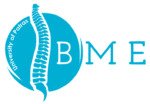| Code | EB4 |
| Type | Elective |
| Semester | B |
| ECTS credits | 4 |
| Teaching Staff | Georgios Athanassiou, Associate Professor, Dept. of Mechanical Engineering & Aeronautics
Despina Deligianni, Associate Professor, Dept. of Mechanical Engineering & Aeronautics Dimosthenis Mavrilas, Associate Professor, Dept. of Mechanical Engineering & Aeronautics |
Aims & Objectives:
To provide the student with basic knowledge, concepts and problems of fluid and solid mechanics necessary for the analysis of blood flow in the macro and microcirculation, and to other physiological flows.
Learning outcomes & Competences:
The students will be able to:
Describe the mechanics of cardiovascular blood flow and apply fluid mechanic flow models to flow in tubes.
Understand physiologically relevant fluid and solid mechanics.
Understand fluid and solid mechanics that are pertinent to blood flow in the heart and blood vessels.
Apply fluid mechanical analyses relevant to biomedical engineering problems.
Conduct fluid mechanical analyses of human circulation, primarily applied to blood flow at the arterial level.
Conduct fluid mechanical analyses of vascular implants (e.g., prosthetic valves) and measurements in the cardiovascular system.
Understand and analyze velocity measurement techniques relevant to blood flow (e.g., MRI, Ultrasound, Doppler).
Prerequisites
Basic knowledge from topics of biomechanics, fluid mechanics, human circulation,cardiovascular system.
Content
Fundamentals of Fluid Mechanics
Intrinsic Fluid Properties, Hydrostatics
Macroscopic Balances of Mass and Momentum, Microscopic Balances of Mass and
Momentum, Bernoulli Equation
Dimensional Analysis. Fluid Mechanics in a Straight Tube, Boundary Layer Separation
Introduction to Mechanics of Materials. Linear elastic solid and linear viscous fluid.
Viscoelasticity, elastic moduli, viscosity.
Analysis of Thin-Walled Cylindrical Tubes. Analysis of Thick-Walled Cylindrical Tubes
Heart. Cardiac Valves, Systemic Circulation, Coronary Circulation
Pulmonary Circulation and Gas Exchange in the Lungs
Cerebral and Renal Circulations
Microcirculation. Regulation of the Circulation. Atherosclerosis
Rheology of Blood and Vascular Mechanics
Rheology of Blood. Linear flux of blood, Casson equation, Rauleaux formation condition.
Static and Steady Flow Models
Hydrostatics in the Circulation, Applications of the Bernoulli Equation
Rigid Tube Flow Models
Estimation of Entrance Length and Its Effect on Flow Development in Arteries
Flow in Collapsible Vessels
Unsteady Flow and Nonuniform Geometric Models
Windkessel Models for the Human Circulation
Continuum Models for Pulsatile Flow Dynamics, Hemodynamic Theories of Atherogenesis
Wall Shear Stress and Its Effect on Endothelial Cells
Flow through Curved Arteries and Bifurcations, Flow through Arterial Stenoses and
Aneurysms
Native Heart Valves. Aortic and Pulmonary Valves, Mitral and Tricuspid Valves
Prosthetic Heart Valve Dynamics
Brief History of Heart Valve Prostheses, Hemodynamic Assessment of Prosthetic Heart
Valves
In Vitro Studies of Coagulation Potential and Blood Damage
Durability of Prosthetic Heart Valves, Current Trends in Valve Design
Vascular Therapeutic Techniques
Teaching and learning methods
Lectures, seminars, laboratory exercises, visits to hospitals & research institutes.
Assessment
Written exam, project assignment, oral project presentation.
